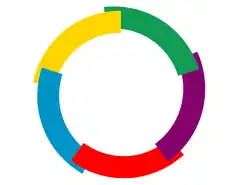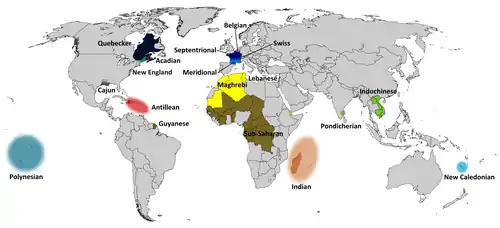Varieties of French
Varieties of the French language are spoken in France and around the world. The Francophones of France generally use Metropolitan French (spoken in Paris and considered standard) although some also use regional dialects or varieties such as Meridional French. In Europe outside France there are Belgian French, Swiss French, and in Italy Aostan French. In Canada, French is an official language along with English; the two main dialects of French in Canada are Quebec French and Acadian French, but also another dialect commonly grouped as Canadian French, used by Anglophones speaking French as a second language or by Francophones in Canada using a different dialect. In Lebanon, French was an official language until 1941 and the main dialect spoken there is Lebanese French or Levantine French. Note that the discussion here refers to varieties of the French language, not to the Romance sister languages (sometimes considered dialects) of French spoken in France (e.g. Picard, Limousin, Gascon, etc.; for these languages see: Langues d'oïl, Francoprovençal, Occitan and languages of France). See also French-based creole languages, which are also considered separate languages.
 |
| Part of a series on the |
| French language |
|---|
|
| History |
| Grammar |
| Orthography |
| Phonology |
|

Africa
French is an administrative language and is commonly but unofficially used in the Maghreb states, Mauritania, Algeria, Morocco and Tunisia. As of 2006, an estimated 115 million African people spread across 31 African countries can speak French either as a first or second language, making Africa the continent with the most French speakers in the world.[1] While there are many varieties of African French, common features include the use of an alveolar trill and use of borrowed words from local languages.
Canada
Acadian
Acadian French is a variant of French spoken by francophone Acadians in the Canadian Maritime provinces, the Saint John River Valley in the northern part of the U.S. state of Maine, the Magdalen Islands and Havre-Saint-Pierre, along the St. Lawrence's north shore. Speakers of Metropolitan French and even of other Canadian dialects have some difficulty understanding Acadian French.
Notable features include /k/ and /tj/ becoming [t͡ʃ] and /ɡ/ and /dj/ becoming [d͡ʒ] before front vowels and the use of some archaic words.
Chiac
Chiac is a dialect of combined Acadian French and English and is spoken mainly around Moncton, New Brunswick. The pronunciation of French words is very different from other dialects and resembles English pronunciation. Chiac cannot be identified solely on its frequent use of English words since many other French dialects use many English words as well, but Chiac has an unusual amount of English. Chiac French has developed through proximity to English-speakers who settled nearby during the colonial period. Sounds that are characteristic of Chiac are the different use of the letters "d", "t", "r", and "c" (such as the word "bec", normally spoken in French with a softer "c" sound but spoken as "beck" with a hard "c" as in the English pronunciation). Other differences include the use of vowel sounds such as "ea", "eo", "on", "an", and "oi". Such English-stylized pronunciations are different from other dialects of North American French such as Québécois and Brayon. Some forms of Chiac deviate from the original language to the extent that it is nearly incomprehensible to the larger francophone community. Chiac is perhaps best categorized as a creole language alongside Haitian Creole and Louisiana Creole, French dialects that incorporate Indigenous, African, and other European languages, as opposed to dialects such as Québécois and Brayon that deviate slightly from Metropolitan French but are nonetheless derived primarily from earlier dialects of French with little contribution from other source languages.
Newfoundland
Newfoundland French is a regional dialect of French that was once spoken by settlers in the French colony of Newfoundland.
Quebec
Quebec French is the dominant and most prevalent regional variety of French found in Canada. Although Quebec French constitutes a coherent and standard system, it has no objective norm since the very organization mandated to establish it, the Office québécois de la langue française, believes that objectively standardizing Quebec French would lead to reduced inter intelligibility with other French communities around the world.
Ontario
Ontario French is often divided into two categories: North and South. The further north the more French is spoken and the closer the dialect and culture is to Quebec French. Further south, the French is closer to the global standard, with a more English cultural influence as well as a more Parisian grammar and dialect structure. Both Parisian and Canadian French are taught in the French immersion schools.
Notable features include [ɪ], [ʏ], and [ʊ] as allophones of /i/, /y/, and /u/ in closed syllables and affrication of /t/ and /d/ to [t͡s] and [d͡z] before /i/ and /y/ (the word tu is pronounced [t͡sy]).
Long vowels are generally diphthongized in closed syllables (the word fête is pronounced [faɛ̯t]).
United States
Several varieties of French emerged in the United States: Louisiana French, New England French and the nearly-extinct Frenchville French, Missouri French, Muskrat French and Métis French.
Louisiana
Louisiana French, the largest of the groupings, is spoken mostly in Louisiana and derives from the forms of the language spoken by the colonists of lower French Louisiana. Louisiana French is traditionally into three dialects: Colonial French, Modern Louisiana French or "Acadian" French, and Louisiana Creole French.[2][3] Colonial French was originally the dialect spoken by the land-holding educated classes. Acadian, the dialect of the Acadians who came to French Louisiana in droves following their expulsion from Acadia during the French and Indian War, was spoken largely by the white lower classes. Louisiana Creole, a creole that developed long before Haitian immigrants arrived in Louisiana, largely developed as the tongue of the Louisiana Creole community and a significant portion of self-identified Cajuns. However, linguists now believe that the Colonial and Acadian dialects have largely merged into modern Louisiana French but remain distinct from Louisiana Creole.[3]
French has gained co-official status with English in Louisiana, and there is both a thriving multi-generational base of speakers as well as a growing network of French immersion schools across the state in order to preserve the language. Louisiana also has a French-language society called CODOFIL (Conseil pour le développement du français en Louisiane).
Missouri
Missouri French is now spoken by a handful of people in the Midwestern United States, primarily in Missouri. It is the last remnant of the form of French once spoken widely in the region known as the Illinois Country, which was colonized as part of French Louisiana. It is considered very moribund, with only a few elderly speakers still fluent.[2]
New England
New England French is the local name for Canadian French as it is spoken in New England,[4] except in the Saint John Valley of northern Aroostook County, Maine, where Acadian French predominates.
Caribbean
Haiti
Haitian French is the variety of French spoken in Haiti.[5] The main difference between Haitian French and the Metropolitan French is in the Haitian speaker's intonation, a rather subtle creole-based tone being used.[5] Importantly, differences are not enough to cause problems between both speakers.[5]
Asia
Cambodian
Cambodian French is the French of Cambodia. It dates back to the French colonization of Indochina in 1863. Colonists taught French to the local inhabitants, especially the Khmer and Chinese. The locals also taught the colonists Khmer and some Chinese spoken variants, such as Teochew and Cantonese. Cambodian French was influenced by Khmer and Chinese spoken variants, and it was spoken by children of French men married to Khmer or ethnic Chinese women.
Cambodian French is still used as a second language in some schools, universities and government offices, but most of the younger generations and members of the business world choose to learn English. Mostly, only older natives still speak French. Since the 1990s, there has been a small revival of French in Cambodia with French-language schools and centres opening. Many Cambodian students travel to France to receive studies as well as French-language media.[6] Nevertheless, Cambodia still has the smallest Francophone population of the three French-speaking Asian countries, the others being Vietnam and Laos.
Indian French
Indian French is the French spoken by Indians in the former colonies of Pondichéry, Chandannagar, Karaikal, Mahé and Yanam. There is a considerable influence from Dravidian languages like Tamil (Puducherry Tamil dialect), Telugu (Yanam Telugu dialect) and Malayalam (Mahé Malayalam dialect).
Lao
Lao French is spoken in Laos. It goes back to the French colonization of Indochina despite a decline in the language after the country's independence and the communist takeover. A revival has now raised the number of students learning French to 35%.[6] In addition, the Laotian élite and the elderly population speak French, which is the diplomatic language of Laos.
Vietnam
Vietnamese French is spoken in Vietnam, which has the largest Francophone population in Asia. Over 5% of the population learn the language or speak it well.[6] French is also spoken among the elderly in Vietnam as a legacy of the colonial French era and also by the country's élite. A French pidgin, Tây Bồi, was spoken by Vietnamese servants in French households during the colonial era. Since the end of the Vietnam War in 1975, the number of French-speakers in Vietnam and the number of students taking the language have declined, but French remains taught as an optional foreign language in higher education.
Europe
Aostan
Aostan French (French: français valdôtain) is the variety of French spoken in the Aosta Valley of Italy, where there is a significant trilingual francophone population. Some expressions, words and phrases are different from Standard French, some of them are similar to Swiss French and some reflecting the influence of Piedmontese language or Italian. Both French and Italian overlay the indigenous local language continuum of Aosta Valley, called Valdôtain (locally, patois), which is Franco-Provençal in type.
Belgian
Belgian French (French: français de Belgique) is the variety of French spoken mainly in the French Community of Belgium, alongside related minority regional languages such as Walloon, Picard, Champenois and Gaumais. Belgian French and the French of northern France are almost identical.
Notable features include a strong distinction between long and short vowels, the lack of the approximant /ɥ/, and the use of certain Belgicisms.
Jersey Legal
Jersey Legal French is the official dialect of French used administratively in Jersey. Notable features include some archaic word choices and the words septante and nonante for "seventy" and "ninety" respectively.
Meridional
Meridional French (French: français méridional) is the regional variant of the French spoken in Occitania. It is strongly influenced by Occitan.
Swiss
Swiss French (French: français de Suisse, Suisse romand) is the variety of French spoken in the French-speaking area of Switzerland known as Romandy. The differences between Swiss French and Parisian French are minor and mostly lexical.
See also
References
- (in French) La Francophonie dans le monde 2006-2007 published by the Organisation internationale de la Francophonie. Nathan, Paris, 2007
- Ammon, Ulrich; International Sociological Association (1989). Status and Function of Languages and Language Varieties. Walter de Gruyter. p. 307. ISBN 0-89925-356-3. Retrieved September 3, 2010.
- "What is Cajun French?". Department of French Studies, Louisiana State University. Archived from the original on September 14, 2010. Retrieved September 3, 2010.
- Ammon, Ulrich; International Sociological Association (1989). Status and Function of Languages and Language Varieties. Walter de Gruyter. p. 308. ISBN 0-89925-356-3. Retrieved February 1, 2012.
- "Haiti French Vs. Paris French". Retrieved 8 February 2014.
- La Francophonie in Asia, France-Diplomatie, 2005, retrieved 2010-10-14
External links
- Learn to type with different French keyboard layouts Francais de Belgique, Francais de Suisse, Francais du Canada, Francais BEPO.
- linguasphere on Romance languages
- (in French) L'Aménagement Linguistique dans le Monde - Vallée d'Aoste, Linguistic situation in Aosta Valley
- (in French) Sondage sur la pratique des langues en Vda
- French in India: A privileged status